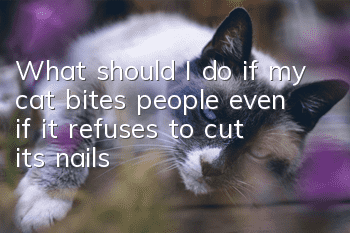What should you pay attention to after urethrostomy surgery in male blue cats?

What should you pay attention to after urethrostomy surgery in male blue cats? Domestic pet cats have a higher incidence of urethral obstruction due to problems with their physiological structure and dietary structure. The usual causes are: urethral edema caused by inflammation, urethral stones, urethral hyperplasia, etc. The disease has an acute onset and obvious symptoms. If not treated promptly, the prognosis is often poor. The most popular method to treat this disease is surgical treatment. This article discusses the treatment experience of a male cat with urethrostomy that was recently cured in our hospital.
Figure 1 The sick cat is depressed
1. Basic situation of the sick animal
The affected cat is a purebred blue cat, 2 years old , male, weighing 4.5 kg, the diet is cat food mixed with pig and cow liver or fish offal for human consumption. In recent days, he had a significant loss of appetite, lack of energy, frequent urination movements but no urine discharge, and sometimes even painful wailing sounds, and the frequency gradually increased, so he came to the hospital for treatment.
2. Examination and diagnosis
1. Clinical examination
The cat was depressed during inspection, with a distended abdomen, and palpation Bladder full of urine. The insertion of the urinary catheter was blocked and artificial catheterization was impossible.
2. Laboratory examination
After manual stabilization, X-ray examination was performed, and urethral and bladder stones were found.
3. Diagnosis
Bladder and urethral stones caused urethral obstruction in this cat, and surgical treatment is recommended.
3. Treatment process of urethrostomy surgery
1. Baoding and anesthesia
Lying on the abdomen in Baoding, with the tail turned forward and the spine Fix it in parallel, and place a 15 cm oval object on the back of the abdomen to make the cat assume a low-front-high posture to fully expose the perineum. Clean the feces in the rectum and insert cotton balls into the anus. The surgical area was shaved and disinfected, and the wound was isolated with a draper. Under general anesthesia, atropine 0 was injected intramuscularly. 2 mg, Serta 50 was used to induce anesthesia, and the patient was connected to a respiratory anesthesia machine.
2. Surgical method
Make an arc-shaped incision on the line connecting the foreskin opening to the anus, with the upper point 1.5 cm away from the anus and downward along the base of the scrotum to the lower end of the foreskin. The opposite side is cut in the same way. The skin and subcutaneous tissue are separated along the incision line and then removed to fully expose the penis and testicles. The spermatic cord was double ligated and cut at a distance of 1 cm to 1.5 cm from the testis, and the total tunica vaginalis and testis were removed. Separate and remove the penile retractor muscles on the penis, pull the penis backward, and cut off the ischiocavernosus and ischiourethral muscles attached to both sides of the penis at the anal sphincter, leaving the penis in a completely free state. Urethrostomy. Clamp the head of the penis with tissue forceps, straighten the penis and insert the catheter. Use ophthalmic scissors to cut the urethra upward from the middle of the urethral opening to the bulbar gland. After clearing the obstruction in the urethra, an assistant can press the bladder appropriately. , to expel urine accumulated in the bladder. Secure the urinary catheter. The medical No. 6 double-lumen urinary catheter is made ofThe urethral orifice of the bulbar gland is inserted into the bladder, and 1 mL of normal saline is injected to inflate the water bladder at the head of the urethral catheter. Use absorbable sutures (4-0) to suture the apex of the urethral incision and the apex of the skin incision with the first stitch of the mucosal skin, and then suture the urethral mucosal skin nodules on both sides of the first stitch, with a stitch distance of about 3 mm, each After 6 to 7 stitches of side suturing, a penetrating button suture is made at the attachment point of the penis and foreskin to transect the penis. The excess skin is sutured with silk knots. Apply iodine tincture, erythromycin ointment, and urine bag.
IV. Postoperative care
To prevent the coat from entering the urethral opening and affecting wound healing, a tail bandage should be applied. Continuous fluid rehydration was required to reduce inflammation for 5 to 7 days after surgery. The urinary catheter and urine bag were removed on the 4th day after surgery; the sutures were removed on the 10th day after the operation. To protect the urinary catheter from breakage, put the affected cat in a dressing gown, hide the urinary catheter in the dressing gown, and fix the external urine bag on the back. The urethral opening is flushed twice a day with antibiotic-containing saline and erythromycin ointment is applied. To prevent infected cats from licking and biting wounds, you can wear an Elizabethan collar. Prescription food for cats with urinary tract diseases.
5. Discussion and Summary
The urethra of male cats is thin and long, with two obvious narrow areas. One is located in the bulbourethral gland and the other is located in the back of the penis. Urethral obstruction occurs in both locations. Causes of cat urethral obstruction include infectious factors, such as urinary tract infection caused by Staphylococcus saprophyticus, Streptococcus, Enterococcus, Pseudomonas, Escherichia coli, Staphylococcus aureus, and Proteus; urethral mucosal damage caused by various factors Or urethra rupture; secondary urethral and bladder stones. Unscientific homemade cat diet is the main factor causing stones. Cats suffering from lower urinary tract obstruction often present with frequent urination, dripping urine, hematuria, anuria, pain and restlessness, and a highly full bladder. Sometimes, although the symptoms can be temporarily relieved by dredging and flushing through the urethra, the symptoms recur repeatedly and cannot be completely cured, so surgical treatment is the only option. In cases of complete urinary tract obstruction, urethral orifice reconstruction is the best treatment option. Urethrostomy is an effective measure to treat refractory urethral obstruction in male cats, and perineal urethrostomy is a commonly used and effective stoma method. For cats with poor general condition and uremia symptoms such as loss of appetite and vomiting, acidosis should be corrected in time, body fluid and electrolyte balance should be adjusted, and fluids should be replenished before surgery. When the bladder is emptied during surgery, fluids should be given immediately. When suturing, the local trauma must be repaired first, so that the skin incision is larger than the urethral incision to avoid inversion caused by excessive skin. When suturing, the mucosa should wrap around the skin, and the skin should not wrap around the mucosa. The mucosa and skin should be closely aligned, and the sutures should not be too tight to ensure that the sutures are not inverted, everted, or pleated. Postoperative care is very important. Careful care must be taken after the operation to prevent the affected cat from biting off or tearing off the urinary tube or urine bag, which may cause a series of sequelae. After surgery, the affected cat should be given adequate drinking water and prescribed cat food to prevent stone formation. Pay attention to removing foreign bodies and blood clots from the urethral opening to ensure that urine is discharged freely through the artificial urethral opening. And pay attention to keeping the local area dry to facilitate wound healing.
Figure 6 Prescription jar
- How to prevent cats from scratching walls. Train cats not to scratch walls.
- How many days should it be safe to isolate a new cat from an old cat?
- Five common feline diseases
- Clinical application of acupuncture in cats, the magical effect of acupuncture in cats!
- Tips for removing black chin in cats
- What does a cat eat to produce a lot of milk?
- The kitten keeps blinking one eye
- What to do if a cat is afraid of people
- There's a reason why cats always lick their fur
- What should I do if my cat refuses to have its nails cut?



